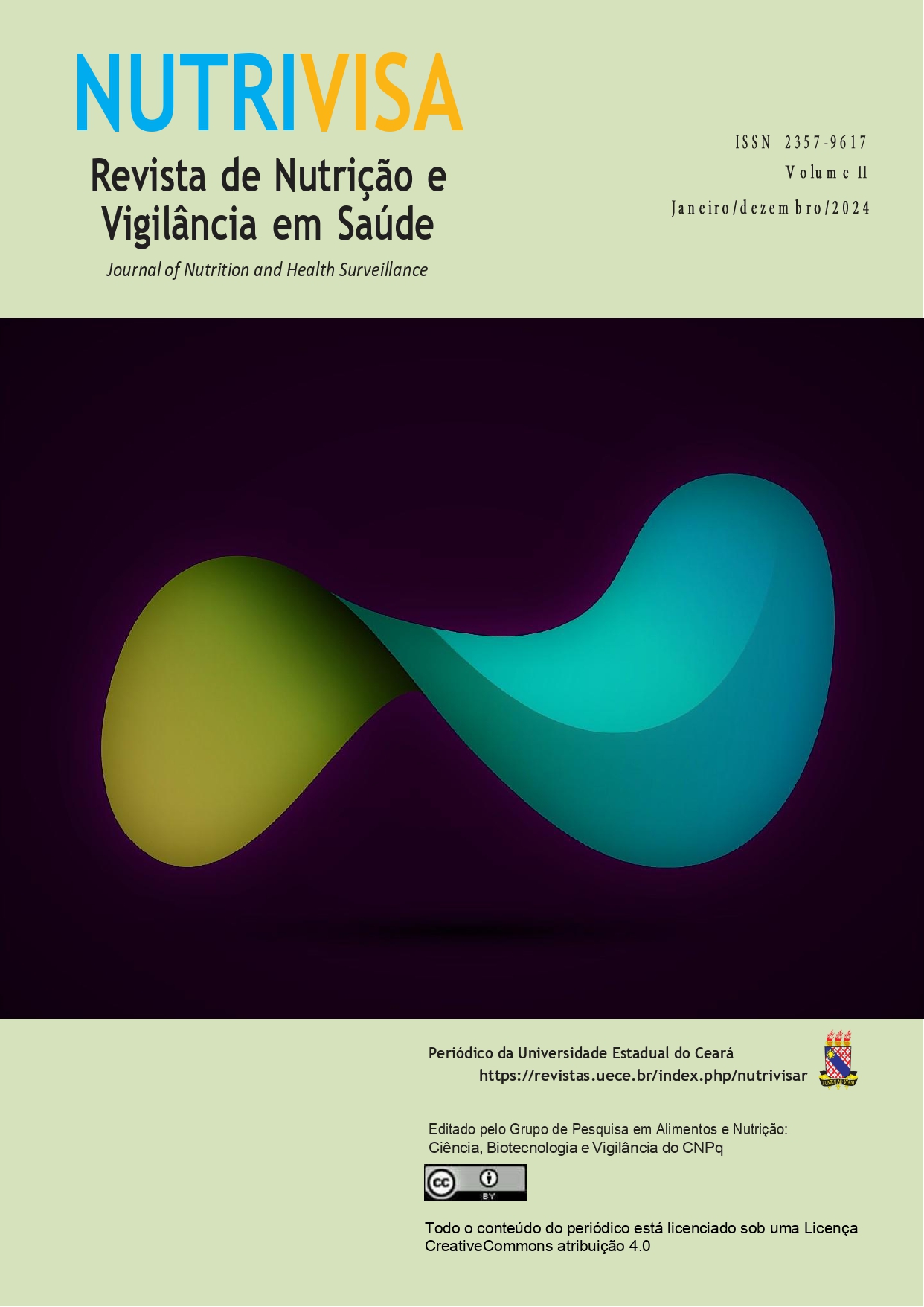Dietary patterns and the association with excess weight in university students in the health area
DOI:
https://doi.org/10.52521/nutrivisa.v11i1.14054Keywords:
diet; feeding behavior; overweight; students; health occupations.Abstract
Enrolling in university can negatively affect the dietary habits of young people, fostering unhealthy behaviors like inadequate intake of fruits and vegetables and excessive consumption of ultra-processed foods, which may lead to weight gain. Examining dietary patterns is a crucial approach for the prevention and management of obesity. This cross-sectional study aimed to identify dietary patterns and their association with excess weight among students in health sciences. Principal component factor analysis, followed by varimax orthogonal rotation, identified four dietary patterns: 'common Brazilian' (rice, beans, chicken, and negative factor loading for pasta); 'bakery' (bread, oil, milk, processed foods, pasta, and cake); 'snack bar' (soft drinks, snacks, sugar, and negative factor loading for fruits and vegetables); and 'regional coffee' (corn-based dishes, eggs, coffee, and negative factor loading for vegetables). Together, these four patterns explained 34.83% of the total variance. Excess weight, defined by a body mass index ≥ 25 kg/m², was observed in 32.4% of the students. Robust variance estimation was employed in Poisson regression to calculate the prevalence ratios of excess weight (outcome) concerning dietary patterns (exposure), controlling for sociodemographic factors, at a significance level of 5%. None of the dietary patterns identified were linked to excess weight in the group under investigation. Therefore, we conclude that the four main dietary patterns identified among the evaluated university students ('common Brazilian', 'bakery', 'snack bar', and 'regional coffee') showed no association with excess weight.
References
BARUFALDI, LA; ABREU, GA; VEIGA, GV; SICHIERI, R; KUSCHNIR, MCC; CUNHA, DB; PEREIRA, RA; BLOCH, KV. Programa para registro de recordatório alimentar de 24 horas: aplicação no Estudo de Riscos Cardiovasculares em Adolescentes. Rev Bras Epidemiol. 2016;19(2):464-468.
BRASIL. Resolução nº 466, de 12 de dezembro de 2012. Diário Oficial da União 2012; 12 dez.
CATALA, LO; TORMO-SANTAMARIA, M. Generational changes in university students food consumption patterns. University of Alicante, 2003-2018. Nutr Clín Diet Hosp. 2019;39(3):115–23.
COCHRAN, W.G. Técnicas de amostragem. 2.ed. Rio de Janeiro: Fundo de Cultura, 1977. 555p.
DENOVA-GUTIÉRREZ, E; CASTAÑÓN, S; TALAYERA, JO; FLORES, M; MACÍAS, N; RODRÍGUES-RAMÍREZ, S; FLORES, YN; SALMERÓN, J. Dietary patterns are associated with different indexes of adiposity and obesity in an urban. J Nutr. 2011;141(5): 921-927.
ECKHARDT, JP; FRANZ, LBB; BUSNELLO, MB; BATTISTI, IDE; BOFF, ET de O. Padrões alimentares e nível de atividade física em adolescentes escolares. Ciênca Cuid e Saúde. 2017;16(2):3–8.
EILAT-ADAR, S; METE, M; FRETTS, A; FABSITZ, RR; HANDELAND, V; LEE, ET; LORIA, C; XU, J; YEH, J; HOWARD, BV. Dietary patterns and their association with cardiovascular risk factors in a population undergoing lifestyle changes: the Strong Hearty Study. Nutr Metab Cardiovasc Dis. 2013;23(6):528–535.
FERNÁNDEZ, MP; LÓPEZ Ortiz, MM. Relación entre hábitos alimentarios y riesgo de desarrollar diabetes en universitarios mexicanos. Nutr Clín Diet Hosp. 2020;39(4):32-40.
FOROUHI, NG. Embracing complexity: making sense of diet, nutrition, obesity and type 2 diabetes. Diabetologia. 2023;66(5):786-799.
GAO, M; JEBB, SA; AVEYARD, P; AMBROSINI, GL; PEREZ-CORNAGO, A; CARTER, J; SUN, X; PIERNAS, C. Associations between dietary patterns and the incidence of total and fatal cardiovascular disease and all-cause mortality in 116,806 individuals from the UK Biobank: a prospective cohort study. BMC Med. 2021;19(1):83.
GIMENO, SGA; MONDINI, L; MORAES, AS; FREITAS, ICM. Padrões de consumo de alimentos e fatores associados em adultos jovens de Ribeirão Preto, São Paulo, Brasil: Projeto OBEDIARP. CSP. 2011;27(3):533-545.
HAIR, JF; BLACK, WC; BABIN, BJ; ANDERSEN, RE. Multivariate data analysis. 7thedn. Englewood Cliffs: Prentice Hall, 2010.
INSTITUTO BRASILEIRO DE GEOGRAFIA E ESTATÍSTICA (IBGE). Pesquisa de Orçamentos Familiares (POF 2017-2018) – Avaliação nutricional da disponibilidade domiciliar de alimentos no Brasil. Rio de Janeiro: IBGE; 2020.
LANGSETMO, L; POLIQUIN, S; HANLEY, DA; PRIOR, JC; BARR S; Anastassiades T; TORHEED, T; GOLTZMAN, D; KREIGER, N. Dietary patterns in Canadian men and women ages 25 and older: relationship to demographics, body mass index and bone mineral density. BMC Musculoskelet Disord. 2010;11(20):1-11.
LI, Y; SUN, Y; WU, H; YANG, P; HUANG, X; ZHANG, L; YIN, L. Metabolic syndromes increase significantly with the accumulation of bad dietary habits. J Nutr Health Aging. 2024 Feb;28(2):100017.
MASSARANI, FA; CUNHA, DB; MURARO, AP; SOUZA, BSN; SICHIERI, R; YOKOO, EM. Agregação familiar e padrões alimentares na população brasileira. CSP. 2015;31(12):2535-2545.
Neres D, Moreira HSB, Soares CLR, Garcia SD, Costa CRL de M. Lifestyle of students in healthcare programs at the Western Paraná State University. RSD. 2024;13(6):e11613646169.
NEWBY, PK; TUCKER, KL. Empirically derived eating patterns using factor or cluster analysis: a review. Nutr Rev. 2004;62(5):177-203.
NOGUEIRA; VC, ARRUDA, SPM; SAMPAIO, HAC; RODRIGUES, BC; SILVA, EB; FARIAS, BO; SABÓIA, KM. Fatores socioeconômicos, demográficos e de estilo de vida associados a padrões alimentares de trabalhadores em turnos. Cien Saude Colet. 2019;24(3):761-769.
PEREIRA-SANTOS, M; SANTANA, JM; CARVALHO, ACN; FREITAS, F. Dietary patterns among nutrition students at a public university in Brazil. Rev Chil Nutr. 2016;43(1):39-44.
PRINCE, MJ; WU, F; GUO; Y, ROBLEDO, LMG; O’DONNELL, M; SULLIVAN, R; SALIM, Y. The burden of disease in older people and implications for health policy and practice. Lancet. 2015;385(9967): 549-562.
PROTANO, C; VALERIANI, F; De GIORGI, A; MAROTTA, D; UBALDI, F; NAPOLI, C; LIGUORI, G; ROMANO Spica, V; VITALI, M; GALLÈ, F. Consumption patterns of energy drinks in university students: A systematic review and meta-analysis. Nutr. J. 2023;107:111904.
ROCHA, NP; MILAGRES, LC; FILGUEIRAS, M de S; SUHETT, LG; SILVA, MA; de ALBUQUERQUE, FM; RIBEIRO, AQ; VIEIRA, AS; NOVAES, JF. Association of dietary patterns with excess weight and body adiposity in Brazilian children: The pase-Brasil study. Arq Bras Cardiol. 2019;113(1):52–9.
SANTOS, IKSD; CONDE WL. Trend in dietary patterns among adults from Brazilian state capitals. Rev Bras Epidemiol. 2020;23:e200035.
SICHIERI, R. Dietary patterns and their associations with obesity in the Brazilian City of Rio de Janeiro. Obes Res. 2002;10(1):42–8.
SUN, J; BUYS, NJ; HILLS, AP. Dietary pattern and its association with the prevalence of obesity, hypertension and other cardiovascular risk factors among Chinese older adults. Int J Environ Res Public Health. 2014;11(4):3956–3971.
TAO, X; SHAO, Y; XU, D; HUANG, Y; YU, X; ZHONG, T; WANG, L; CHUNG, SK; CHEN, D; YU, L; XIAO, Y. Dietary Patterns and Nutrient Intake in University Students of Macao: A Cross-Sectional Study. J. Nutr.. 2022;14(17):3642.
VILELA, AA; SICHIERI, R; PEREIRA, RA; CUNHA, DB; RODRIGUES, PR; GONCALVES-SILVA, RM; FERREIRA, MG. Dietary patterns associated with anthropometric indicators of abdominal fat in adults. CSP. 2014;30(3):502-510.
WORLD HEALTH ORGANIZATION. Obesity: preventing and managing the global epidemic. Geneva: WHO, 1998.
Downloads
Published
How to Cite
Issue
Section
License
Copyright (c) 2024 Ribanna Aparecida Marques Braga, Letícia Atademos de Oliveira, Maria Dinara de Araújo Nogueira, Renata Cristina Machado Mendes, Ilana Nogueira Bezerra, Luis Felipe Nunes de Oliveira , Soraia Pinheiro Machado Arruda

This work is licensed under a Creative Commons Attribution 4.0 International License.














